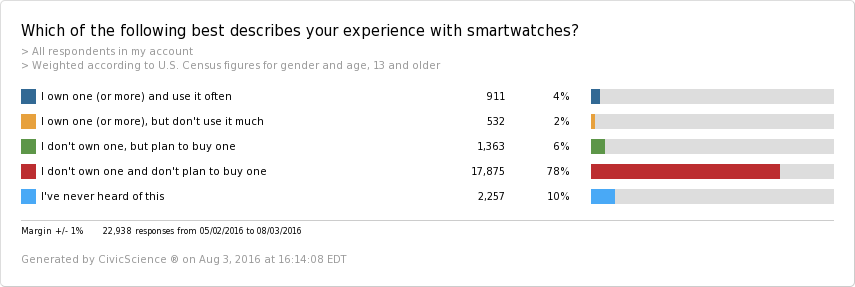Since The Jetsons, techies have been waiting for the smartwatch. As a kid, I vividly recall “placing calls” to imaginary friends using my Casio digital watch. Now, most smartwatches can answer (real) calls, send messages and receive alerts from connected apps. Gone are the days of phantom cellphone vibrations or checking your phone every 10 minutes.
According to Forbes, the smartwatch market will see some serious growth in the coming year. Sales of the technology are expected to jump from 30.32 million sold in 2015, to 66.71 million by 2017. For any smartwatch maker, this figure is music to their ears.
Let’s see what the latest CivicScience data can tell us about the growth of the smartwatch category:
As you can see from these recent numbers, 78% of respondents don’t currently own a smartwatch, and they don’t plan to buy one in the future. That’s a vast majority of the population. 10% of consumers haven’t even heard of smartwatches.
Let’s explore those who already own a smartwatch or are planning to buy a smartwatch. Will this group continue to grow?
The 4% who answered “I own one (or more) and use it often,” are more likely to try new products before other people do. They are also more likely to read technology websites or blogs, and consider brand over price when shopping. These links tie closely to the profile of an early adopter or innovator, brand loyalist who purchase items as soon as they hit the market.
The 2% who responded “I own one (or more), but don’t use it much,” seem to match the early adopter or innovator profile. They also are more likely to consider brand over price, and they are more apt to try new products before other people do. Whether they’re using the smartwatch daily or not, it’s important for these adopters to get their hands on it before anyone else.
Consider the 6% of respondents who don’t own a smartwatch yet, but plan to buy one. Those answering I don’t own one, but plan to buy one are more likely to read technology websites or blogs, and to tell others about new brands and technology. Sound familiar? The above group could still be classified as early adopters. It is worth noting that the 6% interested in purchasing a smartwatch in the future does align with Forbes’ estimate that the market will double.
What does this mean?
Well, it looks like a mix of good new and bad news for the smartwatch industry. On one hand, there is still a lot of room for growth in the category, with the potential to double sales just among the typical early adopter set. On the other hand, the growth is slow. It looks like smartwatch brands have a long way to go before they have mass market appeal.









